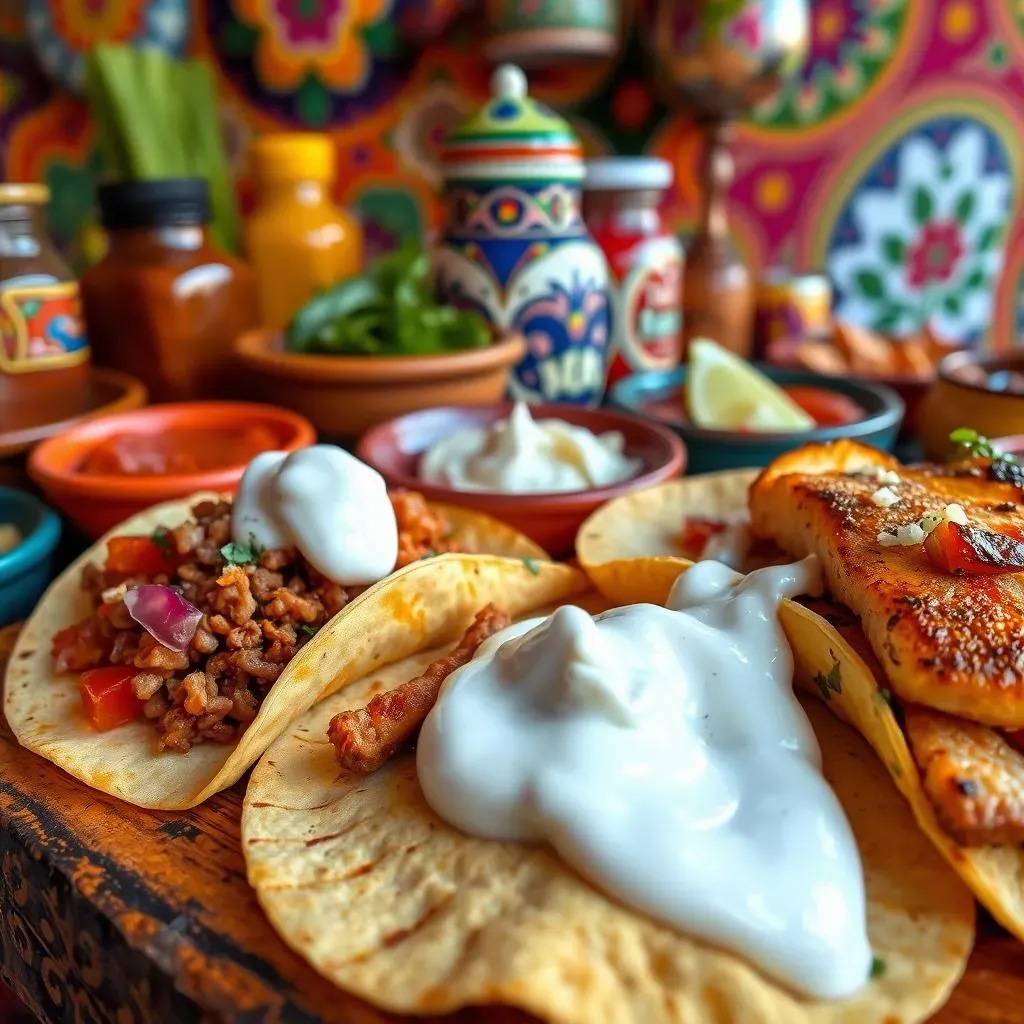Table of Contents
Ever stared down the dairy aisle, wondering about the difference between sour cream and Mexican crema? You're not alone! Both add a creamy tang to dishes, but they're far from interchangeable. Understanding the nuances of sour cream vs mexican sour cream can seriously up your culinary game, especially when it comes to Mexican cuisine. Think of it like this: would you use balsamic vinegar in place of rice vinegar for sushi? Probably not. Similarly, knowing when to reach for sour cream versus crema will elevate your tacos, soups, and everything in between. This article will break down the key differences in flavor, texture, and usage, so you can confidently choose the right dairy delight for your next culinary creation. We'll explore the tangy punch of sour cream and the mellow sweetness of Mexican crema, diving into their textures and best uses. Get ready to unlock the secrets of these two creamy contenders!
The Basics: What is Sour Cream and What is Mexican Crema?

The Basics: What is Sour Cream and What is Mexican Crema?
Sour Cream 101: The Tangy Truth
Alright, let's start with sour cream. Imagine taking regular cream and letting lactic acid bacteria work their magic. That fermentation process is what gives sour cream its signature tangy flavor and thick texture. It's that tang that really sets it apart. Think of it as the slightly rebellious cousin in the cream family. It's not afraid to stand out and add a zing to your dish.
Commercially, sour cream usually clocks in with a fat content between 18% and 20%. This fat content contributes to its richness and that satisfying dollop-able consistency we all know and love. You'll find it chilling in the dairy aisle, ready to top everything from baked potatoes to tacos (well, sometimes tacos!).
Mexican Crema Unveiled: A Milder Approach
Now, let's talk about Mexican crema. Picture this: a cream that's a bit more laid-back, a little sweeter, and definitely thinner than its American counterpart. Mexican crema, sometimes called crema Mexicana, is traditionally made by fermenting heavy cream with buttermilk. This gives it a milder, slightly tangy flavor, but without the sharp bite of sour cream.
The fat content in Mexican crema is typically higher than sour cream, often around 28% or even higher. This contributes to its luxurious, silky texture. Because of its higher fat content and different fermentation process, it has a pourable consistency, almost like a thin sauce. Think of it as the sophisticated, smoother sibling.
Key Differences Summarized: Sour Cream vs. Crema
So, to recap, we have sour cream, the tangy, thick, and slightly rebellious one. Then there's Mexican crema, the milder, pourable, and subtly sweet counterpart. Here's a quick comparison to keep things straight:
Feature | Sour Cream | Mexican Crema |
|---|---|---|
Flavor | Tangy, acidic | Mild, slightly sweet |
Texture | Thick, dollop-able | Thin, pourable |
Fat Content | 18-20% | 28%+ |
Common Uses | Baked potatoes, dips, some taco toppings | Salsas, soups, stews, tacos (often) |
Understanding these core differences sets the stage for knowing exactly when to use each one. Time to move on to flavor!
Flavor FaceOff: Sour Cream's Tang vs. Mexican Crema's Mildness

Flavor FaceOff: Sour Cream's Tang vs. Mexican Crema's Mildness
The Zesty Zing of Sour Cream: A Flavor Deep Dive
Let's get one thing straight: sour cream isn't shy. That pronounced tang comes from the lactic acid produced during fermentation, and it's what makes sour cream such a versatile condiment. It cuts through richness like a boss, balancing out heavy flavors with its bright acidity. Think about a loaded baked potato – that dollop of sour cream doesn't just add creaminess; it provides a crucial counterpoint to the starchy potato and fatty bacon. It's that balance that keeps you coming back for more.
But it’s not just about baked potatoes. Sour cream's tang works wonders in dips, salads, and even some desserts. Ever had a tangy sour cream coffee cake? The sour cream adds moisture and a subtle zing that elevates the whole experience. It's a flavor that can be bold or subtle, depending on how you use it.
Mexican Crema's Gentle Embrace: A Taste of Subtlety
Now, let's wander over to the milder side of the spectrum with Mexican crema. Where sour cream shouts, crema whispers. The flavor is still tangy, thanks to the fermentation process, but it's a much softer, more rounded tang. There's often a subtle sweetness that balances the acidity, creating a more delicate flavor profile. This makes it incredibly versatile in Mexican cuisine, where it can complement a wide range of dishes without overpowering them.
Crema's mildness makes it perfect for drizzling over spicy salsas, enriching soups and stews, and adding a creamy finish to tacos without masking the other flavors. It's like a culinary chameleon, adapting to its surroundings and enhancing the overall taste experience.
Flavor Showdown: Which One Wins?
So, which one is better? It really depends on what you're going for. If you want a bold, tangy flavor that cuts through richness, sour cream is your go-to. But if you're looking for a milder, more subtle cream that complements other flavors, Mexican crema is the way to go. Here's a quick guide to help you decide:
- For a burst of tang: Choose sour cream.
- For a subtle creaminess: Choose Mexican crema.
- For balancing rich flavors: Choose sour cream.
- For enhancing delicate flavors: Choose Mexican crema.
Ultimately, the best way to decide is to taste them side-by-side and see which one you prefer. Your taste buds will thank you!
Texture Talk: Thickness of Sour Cream vs. Pourability of Crema

Texture Talk: Thickness of Sour Cream vs. Pourability of Crema
Sour Cream's Sturdy Structure: The Science of a Spoonful
Let's dive into the world of texture, starting with sour cream. That stuff is THICK. You can stand a spoon up in it, practically. This firmness comes from the way the milk proteins coagulate during fermentation. The lactic acid produced by the bacteria causes the proteins to clump together, creating a dense network that traps water and fat. The result? A creamy, spoonable texture that holds its shape like a champ.
This sturdy structure makes sour cream ideal for dolloping. Think about it: you want that dollop to sit proudly on top of your chili or baked potato, not melt into a puddle. That's the magic of sour cream's thickness at work. It provides a satisfying textural contrast to the dish it's topping.
Mexican Crema's Silky Flow: A Delicate Drizzle
Now, let's compare that to Mexican crema. Forget standing a spoon up in this stuff; it's all about the drizzle. Crema has a much thinner, more pourable consistency than sour cream. This is partly due to its higher fat content, which interferes with the protein network formation. It also often has stabilizers added to help maintain its pourable texture.
That silky flow makes crema perfect for drizzling over tacos, enchiladas, or soups. It adds a touch of creaminess without being heavy or overwhelming. Imagine a perfectly plated taco, adorned with a delicate swirl of crema. It's not just about the taste; it's about the visual appeal too.
Texture in Action: Choosing the Right Cream for the Job
So, how do you decide which texture is right for your dish? Here's a handy guide:
- For dolloping: Sour cream is your best bet.
- For drizzling: Mexican crema is the way to go.
- For adding body to dips: Sour cream's thickness provides structure.
- For a light, creamy finish: Mexican crema won't weigh things down.
Think about the overall texture profile you're trying to achieve. Do you want a bold textural contrast, or a more seamless blend of flavors and textures? The answer will guide you to the right cream. It's all about creating a symphony of sensations on your palate!
Culinary Combat: When to Use Sour Cream and When to Choose Mexican Crema

Culinary Combat: When to Use Sour Cream and When to Choose Mexican Crema
Tacos, Tostadas, and Beyond: A Creamy Decision
Alright, let's get down to the nitty-gritty: when do you actually use each of these creamy delights? Tacos and tostadas are a great starting point. For a classic, tangy taco experience, sour cream can be fantastic, especially with heartier fillings like seasoned ground beef or carnitas. The tang cuts through the richness and adds a refreshing zing. However, if you're working with more delicate flavors, like grilled fish or veggie tacos, Mexican crema is the way to go. It adds a smooth, creamy finish without overpowering the other ingredients. It's all about balance, my friend!
Think about the overall flavor profile. Are you aiming for a bold, in-your-face taco? Sour cream. A more nuanced, sophisticated taco? Crema. And don't be afraid to experiment! Sometimes, a dollop of sour cream on a shrimp taco is exactly what you need to cut through the sweetness. Other times, a drizzle of crema on a spicy chorizo taco will tame the heat and add a touch of elegance.
Soups, Salsas, and Sides: Creamy Complements
Moving beyond tacos, let's talk soups, salsas, and sides. Sour cream can be a game-changer in creamy soups like potato or broccoli cheddar. Its thickness adds body, and its tang provides a welcome contrast to the richness of the soup. For salsas, however, crema is generally preferred. Its mildness allows the flavors of the tomatoes, onions, and peppers to shine through, while still adding a touch of creaminess. A dollop of sour cream in a vibrant salsa verde might be a bit too overpowering, masking the delicate flavors of the tomatillos and cilantro.
When it comes to sides, consider the overall meal. If you're serving a rich, hearty dish, a dollop of sour cream on a side of refried beans can add a welcome tang. But if the meal is already balanced, a drizzle of crema will enhance the flavors without throwing things off. Think of it as the finishing touch, the creamy exclamation point that ties everything together.
Beyond the Traditional: Creative Creamy Applications
Don't limit yourself to traditional uses! Both sour cream and Mexican crema can be used in creative ways. Sour cream can add moisture and tang to baked goods like coffee cakes and muffins. It can also be used as a base for creamy salad dressings or dips. Mexican crema can be used to enrich sauces, add a touch of creaminess to scrambled eggs, or even as a topping for grilled fruit. Get adventurous and see what you can create!
Here's a quick cheat sheet to keep in mind:
- Bold Flavors: Sour Cream
- Delicate Flavors: Mexican Crema
- Thickening: Sour Cream
- Drizzling: Mexican Crema
- Experimentation: Both!
Ultimately, the choice between sour cream and Mexican crema is a matter of personal preference. There's no right or wrong answer, only delicious possibilities. So, grab a spoon, taste them side-by-side, and see which one you prefer. Your taste buds will guide you!
Sour Cream vs. Mexican Crema: A Culinary Choice
So, there you have it: the lowdown on the creamy clash of sour cream and Mexican crema. While both bring a delightful richness to your dishes, their distinct flavors and textures make them suitable for different culinary adventures. Whether you're aiming for a zesty topping or a smooth, cooling finish, understanding the difference between sour cream vs mexican sour cream empowers you to make the perfect choice. Now go forth, experiment, and elevate your Mexican-inspired meals with the knowledge you've gained!